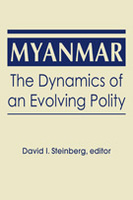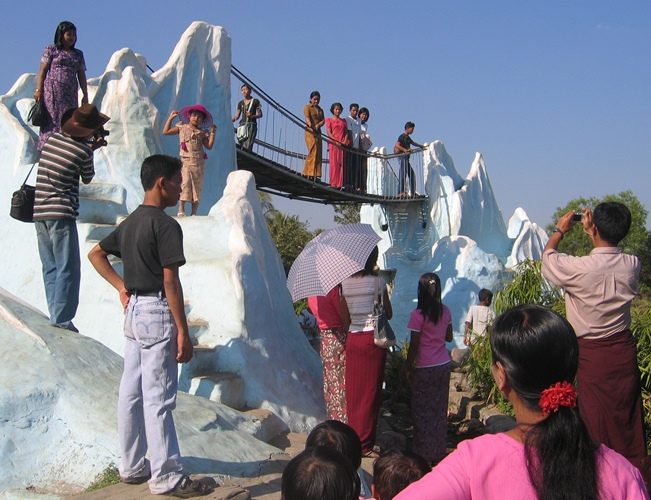 David I Steinberg (ed.). Myanmar: The Dynamics of an Evolving Polity.
David I Steinberg (ed.). Myanmar: The Dynamics of an Evolving Polity.
London: Lynne Rienner Publishers, 2015.
Reviewed by Dr Amrita Dey
This volume compiles the real issues and actors pulling back Myanmar’s full-fledged democratic transition, since its propagation in 2008. The book comes to terms with “on the ground” factors bothering Burmese society–a continuing prominence of the military; a messy legislative process; an inherent tension between Burmese customary concepts and practices and Western concepts of justice and rule of law; the positive effects of economic reforms that have yet to filter down to the populace; a challenging ‘peace process’ and an exclusionary Buddhist nationalism that undermines the integration of extensive minority religious communities. The authors draw a conclusion from these recurring changes in Myanmar that is, in a nutshell, pragmatic, detailed, and unbiased.
In his own chapter on ‘The Persistence of Military Dominance,’ Professor David Steinberg analyzes why the military in Burma/Myanmar (better known as Tatmadaw) has been able to continue in effective control for over half a century. While various opinions have been proposed, one that may have been overlooked in most discussions is the apparent control of the military over all avenues of social mobility. As Steinberg notes, this control could be erased not by elimination but by amelioration of military power over the legislature through the development of diverse opportunities for them. These changes, according to Steinberg, must “emanate from the government” itself. If censorship is lifted, if universities begin the process of free inquiry, and if legislatures at the provincial level have greater opportunity to contribute to social change, then the country will be strengthened and the military will resume its guardian function, rebuilding its reputation that was lost in previous decades. The author takes a pragmatic overview of the problem related to the military in Myanmar and successfully proposes a solution: the integration of Myanmar’s Tatmadaw within the society without erasing or curtailing its influence.
Similarly, Mathew Walton’s chapter on ‘Buddhism, Politics and Political Change’ is a milestone in examining the role of Burmese monks in Myanmar’s transition to democracy in recent years. Writing about a country where publicly questioning a monk is unthinkable, this chapter delves into the ways in which prominent monks have been at the forefront of prodemocracy demonstrations and how they have sought to situate democratic values within a Buddhist context. According to them, Buddha’s teachings contain the essence of democracy–the Kalama Sutta, a teaching that many democratic activists in Myanmar revere and which General Aung San also championed. In this Sutta, Buddha advised his disciples not to accept something as truth merely because of tradition or because their parents or teachers told them it was true, or even because the Buddha himself preached it. They should examine it and only when they themselves have determined that it is true should they accept it as truth. As Buddha never forced his disciples to believe or act in certain ways, he showed that his religion- Buddhism- was also one of free choice, quite compatible with democratic ideas of free choice and liberty.[These ideas are equally consistent with Daw Aung San Suu Kyi’s call for democracy and her emphasis on the causal links between the conduct of the ruler and the prosperity of the nation, as she says: “People who would build a nation in which strong, democratic institutions are firmly established as a guarantee against state-induced power must first learn to liberate their own minds from apathy and fear.”](p.120)
The next two chapters deal with ethnic politics in a ‘Time of Change.’ As Martin Smith and Ashley South argue, ethnic grievances and armed conflict weaken the probability of inclusive peace and sustainable development in a country that aims for “nothing less than transition from half a century of military rule and authoritarianism to democracy.” (pp.135-190) Together, these chapters support the view that a nation-wide ceasefire, which all sides find politically acceptable and are prepared to commit to, can pave the way for inclusive peace, reconciliation, and reform in Myanmar.
There are five other chapters on Economic Reforms, Land Rights, ‘China and Myanmar’ and ‘US and Myanmar Relations.’ Moe Thuzar and Tin Maung Maung Than, in their chapter ‘Economic Reforms: Expectations and Realities,’ argue that Myanmar is ‘up’ for some serious business, whether it be in the banking sector, inviting foreign investors to develop its special economic zones, lifting of sanctions and embargoes to ease the constraints on Myanmar’s economic opening, or enacting a new labor law to create space for workers to voice their dissatisfaction over low wages and form trade unions to vent their grievances. These developments blend well with Myanmar’s quest to catch up with the rest of the region. The chapter ends with proper admonitions regarding a number of issues that contribute to people’s uncertainty on the ground over who the legitimate economic actors in Myanmar are today, including the prevention of bribery and corruption to implement good governance, how the pace of ‘change’ matches the expectations of some but falls short for many others, how economic growth promises to offer new job opportunities and the scope of improvement and competitiveness to all at home and abroad.
Christina Fink’s chapter on ‘Re-envisioning Land Rights and Land Tenure’ focuses on land rights and land use in Myanmar as previous authoritarian governments arbitrarily confiscated land from its people to forge large-scale infrastructure projects, extract resources, and lay the foundation for industrial ventures. Although President Thein Sein’s government has recognized the seriousness of the problem and enacted laws related to the Farmland vis-├а-vis vacant, fallow, and virgin lands, there remains a great deal of ambiguity concerning promises ‘made’ and actions taken on the ground. For instance, property holders are to be issued official land-use certificates which in theory must make land tenure more secure than in the past. But the Farmland Law reaffirms Article 37 (a) of the 2008 constitution, which states that “the Union is the ultimate owner of all lands and all natural resources above and below the ground, above and beneath the water and in the atmosphere in the Union.” (see Robert B. Oberndorf, Legal Review of Recently Enacted Farmland Law and Vacant, Fallow, Virgin Lands Management Law, Yangon, 2012, pp.19-20) This gives free reign to the government to construct special economic zones, hydropower dams, mines, or any other project the ministries think will be beneficial, although the law states that the government must pay compensation in such cases. The chapter succeeds in revealing the truth behind the administration’s proclamation of rule of law and clean governance.
On Myanmar’s foreign policy, Yun Sun terms Sino-Myanmar relations an ‘asymmetric dependence,’ one that began optimistically following Myanmar’s international isolation after the 1990 general elections, when it lacked allies closer to home and farther abroad. This situation tilted Myanmar towards China. China’s dependence on Myanmar stemmed from ‘continued loyalty’ of Myanmar and Beijing’s growing aspiration to exploit Naypyitaw’s economic and strategic resources. However, since 2011 Myanmar has been moving in a different direction, and so has its alignment with China. This change had led to speculations as to whether Myanmar should seek a new “ally”- most likely the United States- or return to its neutralist non-alignment strategy. While Yun Sun favors Myanmar’s return to its nonalignment policy, he agrees that Myanmar should resort to economic pragmatism while seeking multilateral engagements to balance China’s strong influence within the country.
With Washington, of course, what was marked by ‘ostracism’ in the past has been turned towards ‘action-for-action’ Under the Obama-Thein Sein agreement, Myanmar took several bold decisions towards ‘democratization,’ including the release of political prisoners, passing new legislation, and enabling Aung San Suu Kyi and the NLD to participate as a constitutionally legitimate opposition in Parliament. But there are ‘stumbling blocks’ in US-Myanmar bilateral relations, says Jurgen Haacke, including constitutional hiccups over Amendment of 59f, ethnic conflict, communal violence, military and trade relations with North Korea, and concerns as to how Myanmar’s government aims to balance the US presence without hampering its cooperative and stable relations with Beijing. Intriguing chapters indeed, but they are half-hearted without discussion on India-Myanmar relations and other regional countries like Japan and Singapore.
The volume concludes with a fascinating chapter on ‘The Road Toward Change and Development’ by Professor Steinberg. He studies the fundamental problems bothering Myanmar in the present that will extend into the future, such as institutional weakness, ethnic policy, explosive humanitarian issues, reforms aimed at the benefit of the regional community, and how Myanmar will attempt to reinvent its Cold War neutralism to fit contemporary world conditions. The answers/reasons Steinberg offers to these problems can be succinctly termed as ‘practical, detailed and unbiased.’ This chapter is a must-read for scholars who wish to learn more about the long-term impact of the democratic transition on Myanmar, as well as whether it is truly viable or not. .
Overall, the volume is a timely contribution following the pace of political change in Myanmar. However, one should note the issues it missed– discussion on women’s representation in the Parliament, the aspiration of young students and unemployed educated youth, and the problems related to doing business in transitional Myanmar. The inclusion of these issues would have distinguished the volume from other books on post 2011 Myanmar.
Dr Amrita Dey is a Fellow at the Maulana Abul Kalam Azad Institute of Asian Studies in Kolkata.
 Facebook
Facebook  Twitter
Twitter  Soundcloud
Soundcloud  Youtube
Youtube  Rss
Rss 